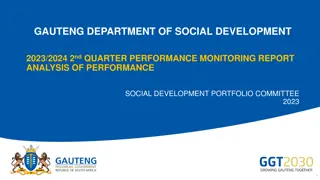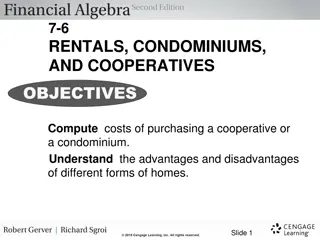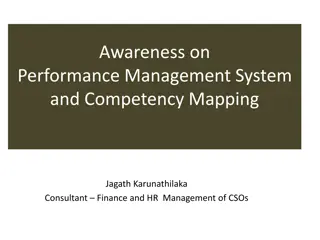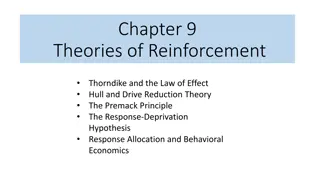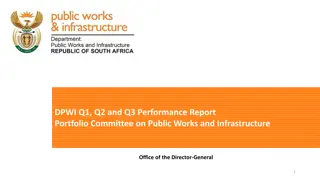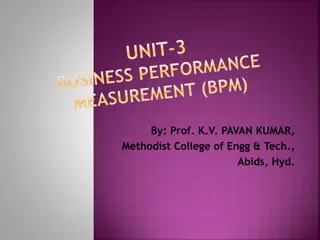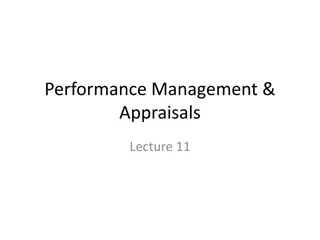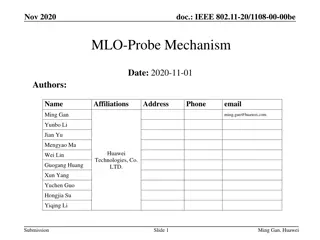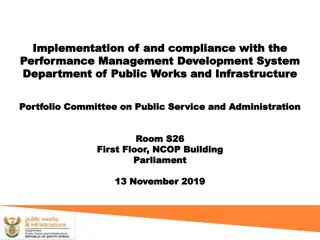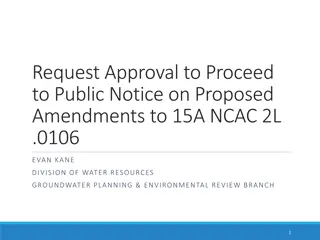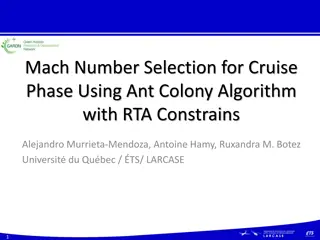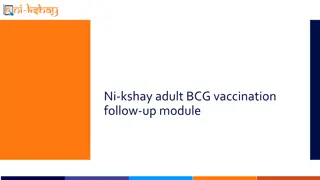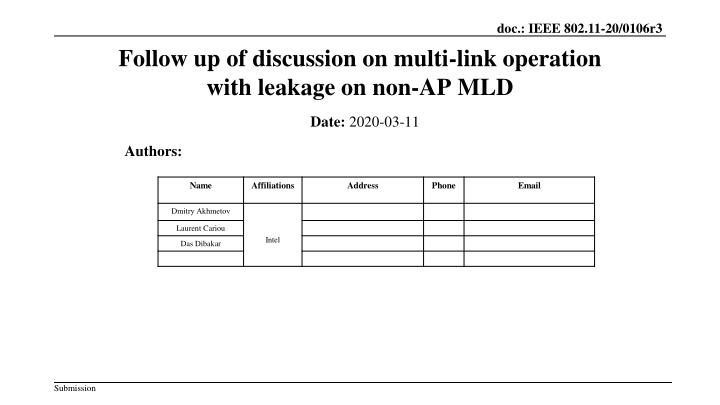
Enhancing Multi-Link Operation Efficiency in IEEE 802.11-20
Explore the latest advancements in multi-link device operations within IEEE 802.11-20 standards, focusing on aspects like channel access capabilities, performance gains, limitations due to radio coexistence, and strategies to mitigate cross-link interference. Discover the preferred modes of operation, proprietary rules for interference mitigation, and performance comparisons for different scenarios.
Download Presentation

Please find below an Image/Link to download the presentation.
The content on the website is provided AS IS for your information and personal use only. It may not be sold, licensed, or shared on other websites without obtaining consent from the author. If you encounter any issues during the download, it is possible that the publisher has removed the file from their server.
You are allowed to download the files provided on this website for personal or commercial use, subject to the condition that they are used lawfully. All files are the property of their respective owners.
The content on the website is provided AS IS for your information and personal use only. It may not be sold, licensed, or shared on other websites without obtaining consent from the author.
E N D
Presentation Transcript
doc.: IEEE 802.11-20/0106r3 Follow up of discussion on multi-link operation with leakage on non-AP MLD Date: 2020-03-11 Authors: Name Affiliations Address Phone Email Dmitry Akhmetov Laurent Cariou Intel Das Dibakar Submission
doc.: IEEE 802.11-20/0106r3 Recap [1]: EHT MLLE 1 In [1] we proposed classification of multi-link device operations based on channel access capabilities SPC single primary channel operation MPC multiple primary channel operation JMPC join multiple primary channel operation We discussed performance of such modes in comparison with a single link operation ~1.27x gain for SPC mode of operation ~2.09x gain for MPC mode of operation ~2.22x gain for JMPC mode of operation We concluded that MPC seems to be preferable mode of operation over other modes because Other modes of operation brings fairness issues Other modes overcomplicate standard development while MPC is a naturally reuse existing access mode Chances of achieving synchronous operations are small STA STA Link 2 Link 1 STA STA EHT MLLE 2 Submission 2
doc.: IEEE 802.11-20/0106r3 Recap [2]: In [2] we discussed limitations raised by radio coexistence issues of co-located radios TXOP TXOP MLLE STA Tx data Tx data Tx data Rx ack Rx ack Rx ack band 1 STA1 3 2 1 0 4 3 2 1 0 5 TXOP Tx data TXOP Rx ack Tx ack R x Rx data Tx data band 2 Tx data Tx Rx ack STA 2 Rx ack 1 0 We introduced two modes of operation to address operations with constraints: Isolated RMPC Leakage/interference from TX on link1 is not sufficient to cross ED threshold on link2 Leakage sufficient to harm data frame receptions on a high MCSes but not enough to damage RX of control frames reception Non-isolated RMPC Leakage from TX on link1 is sufficient to cross ED threshold on link2 Leaking power rise CCA Busy signal on link 2 stopping it from contention and destroying all ongoing RX events/processes Submission 3
doc.: IEEE 802.11-20/0106r3 Recap [2]: For both modes of operation we discussed a number of proprietary rules to mitigate cross link interference, e.g. do not initiate TX operation if other link/radio is in RX state unless STA is not an intended receiver of that transmission do not initiate TXOP if a response is expected on link 2 do not initiate TXOP if STA on link 2 is going to send a response frame on link 2 if the other link/radio is in TX state, limit own TX duration to match end of the other transmission If status of link 2 does not allow MLLE STA to initiate TXOP, restart backoff counter on link 1 We showed that for STAs that have Tx/Rx constraints, in both isolated and non isolated RMPC mode of operations preform much better than fully synchronized access MPC mode of operation: DL case: 2.07x; isolated RMPC mode of operation: DL case: 1.91x; non-isolated RMPC: DL case: 1.6x* ; SPC mode of operation: DL case: 1.27x; * Note: performance gain varies a lot depending on a BSS load from 1.16 with 25% BSS load to 1.77 with 100% BSS load and OBSS loads of 10% to 40% Even with Tx/Rx constraints, RMPC still can provide benefits in terms of reduced latency for UL traffic Both for RTA-like traffic and heavy bursty traffic 30% and more improvement observed for congested networks MLLE performance is better the sooner it can resolve RX activity on a busy link Based on [1] and [2] we conclude that preferable in terms of Channel Access mode of operation (or TXOP initiation) is asynchronous mode of operation a.k.a. Multiple Primary Channels mode (MPC) Submission 4
doc.: IEEE 802.11-20/0106r3 Recap: Lowlight/downsides/bright sides of Sync/JMPC access What is it: Sync, one primary channel and a secondary channel 80+80 type of operation already exist in a spec Contend on a dedicated primary channel/link, access to the medium on a secondary\other\second link by doing ED for PIFS time JMPC, multiple primary channels with join contention Newmode that has to be defined in a spec All links contend for medium, access to the medium on another link a by doing ED for PIFS time Why it is attractive Allow easy link aggregation in both DL and UL Seems to be a solution for non-STR operation synchronous access which naturally align TX/TX and RX/RX operations Why it is not attractive Regulatory restriction\prohibition on access to a medium with PIFS access Limited applicability Synchronous access only works in clean environment (no OBSS/legacy/hidden nodes around) JMPC is independent of environment but chances of join medium access are not high JMPC has fairness issues If implemented for Multi-Link operations may provide a door for channel access abuse (see backup) Submission 5
doc.: IEEE 802.11-20/0106r3 Recap conclusion Asynchronous mode offers the best performance when there is no leakage between links at non- AP MLD side Asynchronous mode for constrained operations with proprietary TX/TX or Rx/Rx alignment solutions offers very good performance when the leakage is low (backoff is still possible) and reasonably well when the leakage is high. Fully synch mode shows gains only where there are no OBSSs on one link but in this situation a proprietary solution on asynch mode will provide similar gains So we believe that asynchronous mode of operations (i.e. MPC or Multipe Primary Channels) is well suited unified existing solution for all modes of operation which only require minor tweaks to manage interference/leakage in some cases Submission 6
doc.: IEEE 802.11-20/0106r3 Assumptions We assume STR AP MLD and non-STA STA MLD is more viable combination, at least from R1 spec perspective In order to get most from multi-link opportunities, an AP MLD shall be STR capable Therefore only focus on scenarios where non-AP MLD side suffers from leakages As AP MLD has STR capabilities, DL might be much easier to handle. In reality, most of the traffic (80%-90%) is downlink Most likely, a STAs willing to implement multi-link aggregation will be measured based on their DL throughput UL traffic is smaller, moreover device with constraints will be self-synchronized on link(s) for UL transmission As we showed before latency benefits preserved even in presence of leakage on a STA side With async channel access start of PPDU can totally be independent. that s what will provide much better performance than fully synch mode with start of PPDU alignment What happen is we do nothing on handling TX/RX constraints in DL direction? Submission 7
doc.: IEEE 802.11-20/0106r3 Do nothing, DL only case Do nothing at all issue is only that the transmission of BA on one link will force misdetection of some MPDUs of an A- MPDU on the other link. backoff DL PPDU AP 1 STA 1 BA STR AP MLD Non-STA STA MLD backoff DL PPDU lost AP 1 STA 2 BA Or loss of the end of A-MPDU due to the losing of sync after interference depending on level of interference/bad/weak implementation of tracking backoff DL PPDU AP 1 STA 1 BA STR AP MLD Non-STA STA MLD backoff DL PPDU lost AP 1 STA 2 BA Submission 8
doc.: IEEE 802.11-20/0106r3 Do nothing Corner case: 1 MLD AP + 1 MLD STA of ~1.5x 1.8x vs single link Generic case: 1 AP + multiple STAs ~1.9x gain in case of partial AMPDU losses ~1.5x 1.8x gain in case of lost the end of AMPDU Note: Provided results include effect of loss of entire PPDU if response BA happens during preamble reception Submission Slide 9
doc.: IEEE 802.11-20/0106r3 Do something, DL case: Issue occurs only at the end of PPDU, where one solution is to have alignment (end roughly at the same time) As it s alignment at the end of the PPDU, achieving this is much easier backoff DL PPDU AP 1 Option 1: AP MLD is capable of signaling end of PPDU time between links STA 1 BA STR AP MLD Non-STA STA MLD backoff DL PPDU STA 2 AP 1 BA Option 2: end of PPDUs can be forced be on boundaries that are known to both APs (on every ms boundary for instance ) DL PPDU DL PPDU AP 1 STA 1 TXOP1 STR AP MLD Non-STA STA MLD TXOP2 DL PPDU DL PPDU STA 2 AP 1 Submission 10
doc.: IEEE 802.11-20/0106r3 Do something, DL case: Option 3: If APs have no other ways to quickly indicate end of PPDU, while STA has synch abilities, we could also just have an RTS/CTS on second link, where the CTS gives back the PPDU end time on the other link if there is an ongoing reception Require new frame format RT S lo st backoff DL PPDU 1 AP 1 STA 1 CT S BA STR AP MLD Non-STA STA MLD RT S backoff DL PPDU 2 STA 2 AP 1 CT S BA Include information about PPDU1 duration Allow PPDU end alignment Option 4: Clever use of delayed BA Submission 11
doc.: IEEE 802.11-20/0106r3 PPDU alignment analysis, DL case For each transmission PPDU size is: Random case: PPDU size randomly selected between 2 and MAX PPDU size (64/256/512/1024) and MAX PPDU duration Constant case: PPDU limited by MaxPPDU size and Max PPDU duration 64, 256, 512 and 512 1 STA, 1 AP, 2x2x80, MCS11 BA/AMPDU size : 64, 256, 512, 1024 Submission Slide 12
doc.: IEEE 802.11-20/0106r3 PPDU alignment analysis, DL case Overall gain over single link varies between 1.4x and 1.9x for the case with RTS OFF and between 1.1x and 1.8x when RTS is ON PPDU alignment works better than Do Nothing option with fixed PPDU size, but difference is insignificant when RTS is OFF PPDU alignment does not provide benefits over Do nothing option when RTS is ON Submission Slide 13
doc.: IEEE 802.11-20/0106r3 Intermediate conclusion For DL only use case in a frame exchange between STR AP MLD and non- STR STA the Do Nothing option provide similar performance to PPDU alignment option In case if MLD AP is able to perform end of PPDU alignment it can be done in proprietary way End of PPDU alignment is not a universal solution and specific to scenario/use case If TX sequence involve anything more than A-MPDU/BA exchange (i.e. RTS/CTS) the gain of alignment disappears. Submission Slide 14
doc.: IEEE 802.11-20/0106r3 Notes on DL and UL traffic coexistence DL traffic : DL traffic prevail in a network, so addressing DL aggregation would be logically the first thing to do We assume AP MLD side does not suffer from leakages so DL might be easier to handle Simulation results shows that in DL only case w/o applying any special techniques we get decent performance No need to develop complex schemes or mandate certain behavior to handle DL UL traffic is important, but much smaller comparing to DL traffic non-STR device is self aware about constraints and in most cases will be self-synchronized between links TX on one link stop/pause the other link so device is naturally should does not hurt self RX operations So, separately DL and UL traffic are not a concern to each other in a communication between STR AP and non-STR STA Submission Slide 15
doc.: IEEE 802.11-20/0106r3 What seems more important for constrained devices Is to have a separation of DL and UL traffic in time To avoid uncontrolled DL/UL mix but to have only UL or DL over a period of time, As we have shown before, DL case perform well for STR AP non-STR STA combination It turn, UL is self-controlled at non-STR STA (one link block the other preventing a mix of TX and RX ops) It is a general understanding that STA, unlike AP, will have better/tighter link integration/interaction, so quick state signaling or operation management is possible A separation of DL and UL traffic would solve UL/DL mix use case Few possible options to organize that: TWT negotiation to say only DL/Triggered UL or only EDCA based UL during the SP, Or a signaling so that STA controls when DL can start or not , e.g., STA stays in DL Rx unavailable state in both links during EDCA based UL transmission so that AP does not transmit DL frames during that state. STA comes out of that state to be able to receive DL packets on both links. May require changes to existing PSM signaling to cover some cases (e.g., U-APSD). Or may be have special rules to disallow certain operation on links per TXOP basis For instance, mandate RTS/CTS exchange when talk to/from non-STR device and have special rules for CTS response to indicate STA unavailability for operation on a certain link during TXOP Submission 16
doc.: IEEE 802.11-20/0106r3 DL-Rx unavailable state The STA can signal when it is unable to receive DL frames by a one bit signaling in UL frames (incl. Data or BA frames). On reception of this frame and after ACKing, the AP does not transmit any DL Data frames to this STA regardless of the power state and modes of that STA starting the end of current TXOP By default the signaling is done independently on all links. DL-Rx Available = 0 DL-Rx Available = 1 Non-AP MLD AP MLD AP 1 STA 1 Link 1 AP 2 STA 2 Link 2 time Suspend DL Data frames : Ack : UL Data : DL Data : U-APSD SP : STA in Doze Submission 17
doc.: IEEE 802.11-20/0106r3 Desirable direction of development Agree on capability indication and let AP and STA to handle indicated restrictions in proprietary way as much as possible Treat each STA of an MLD as a device with independent channel access mechanism and avoid defining methods for artificial synchronous channel access modes Together this open a door for any proprietary mechanism to address TX/RX operations with leakage as long as they follow basic channel access rules of each individual device Use existing mechanisms to enable TX/TX and RX/Rx operations through traffic separation Update/provide extra tools for quick signaling of STA unavailability for certain type of operation Refer to 0455r0 submission for more details Submission 18
doc.: IEEE 802.11-20/0106r3 December 2019 Straw poll 1 Do you agree for R1 spec version to reuse existing channel access mechanism as a mechanism to initiate TXOP operations on any link of MLD device? Submission Slide 19
doc.: IEEE 802.11-20/0106r3 December 2019 Straw poll 2 Do you agree as a part of R1 spec for an AP to advertise whether it is capable of aligning end of PPDU alignment in DL to a non-STR non-AP MLD. The alignment procedure is implementation-specific Submission Slide 20
doc.: IEEE 802.11-20/0106r3 December 2019 Straw poll 3 Do you agree as a part of R1 to define a way for the for non-AP STA to indicate its unavailability to receive DL frames at that time Note: Following that indication and acknowledgement, the AP should not transmit to the STA data frames in DL, while the STA will be able to transmit data frames in UL Submission Slide 21
doc.: IEEE 802.11-20/0106r3 References [1] 11-19-1291-03-00be-some-aspects-of-multi-link-op-performance, Intel [2] 11-19-1541-01-00be-performance-aspects-of-multi-link-op-with constraints, Intel [3] 11-20-0081-00-00be-mlo-synch-transmission, Broadcomm [4] 11-20-0455-00-00be-async-mlo-for-non-str-sta, Intel Submission 22
doc.: IEEE 802.11-20/0106r3 Backup Submission 23
doc.: IEEE 802.11-20/0106r3 December 2019 Risks with a sync mode We don't want to break backoff rules and allow an AP that is in synch on a channel with other contending STAs to be able to ignore backoff and just follow NAV + CCA This is different from secondary channel access, as the STA accessing secondary channel is not in synch with the other contending STAs (does not know when the CP occurs). The other link is an independent link with independent channel access aligned with other devices operating on that link There are regulatory restrictions to do PIFS access on independent channel/link Risks of unfairness if we go full-sync direction: A sync AP MLD with an AP1 alone on link 1 and with an AP2 sharing medium with other AP(s) on link2. If that AP1 carefully chooses TxOP duration on link 1 to always end (Backoff time) before TxOP on link2, so that AP1 ends backoff right at the start of the CP on link 2: this way, link2 is always gained by the AP2. Basically if we allow this mode, there is a clear potential abuse. CP CP TxOP1 TxOP1 Backoff Backoff P I F S P I F S TxOP2 TxOP2 Submission Slide 24
doc.: IEEE 802.11-20/0106r3 Further details The signaling may also include the time at or after which it is valid. A default value signals its valid right after transmission of this frame. By default the signaling is done independently on all links. DL-Rx Available = 0 after T us DL-Rx Available = 1 after 0 us Non-AP MLD AP MLD AP 1 STA 1 Link 1 T AP 2 STA 2 Link 2 time Suspend DL Data frames : Ack : UL Data : DL Data : U-APSD SP : STA in Doze Submission 15
doc.: IEEE 802.11-20/0106r3 Signaling in BA For faster indication the signaling could be included in UL BA frames. We can use few Reserved bits in BA to signal the same. B0 B1-B4 B5 B6-B11 B12-B15 BA Ack Policy Reserved DL-Rx Unavailable BA Type Reserved TID_Info Modified BA Control field to signal STA unavailability for DL Rx. Submission 26
doc.: IEEE 802.11-20/0106r3 PPDU alignment, DL case 1 AP, 1 STA 2x2x80, MCS7 AMSDU ON 64 A-MPDU size Note: Provided results include effect of loss of entire PPDU if response BA happens during preamble reception Submission Slide 27


